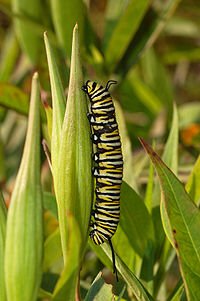
Photo from wikipedia
Carcass decomposition could be considered as a common phenomenon in nature. However, during degradation processes, animal carcasses produce many toxic and harmful metabolites, posing potential ecological risks to water safety,… Click to show full abstract
Carcass decomposition could be considered as a common phenomenon in nature. However, during degradation processes, animal carcasses produce many toxic and harmful metabolites, posing potential ecological risks to water safety, thereby threatening human health. However, the metabolites produced by decomposition of animal corpses are not well understood. In this study, building on our previous baseline study of microbial community between the experimental groups (with animal carcasses) and control groups (without carcasses), the samples at the ultimate stage (19th day) of carcass decomposition were chosen to investigate the metabolic profiles and uncover the relationships between water quality, microbes and noxious metabolites in two types of water (Yellow River water and tap water) using fish as animal model by widely targeted metabolomics. Our results showed amino acid metabolomics, indole and its derivatives, and pyridine and pyridine derivatives mainly occurred in the corpse groups, suggesting that these metabolites are markers of carcass decomposition. And some noxious metabolites (e.g., polyamine, amines, and benzene and substituted derivatives) highly associated with carcass decomposition, which revealed new insights into how to investigate the hazard materials in water. And these noxious metabolites in the corpse groups were even increased 214543-fold in average compared with the control groups. Meanwhile, treatment was the most important factor affecting the water metabolites while microbiome contributed a small proportion to the metabolic profiles. Several opportunistic pathogenic genera Comamonas, Bacteriodes and Alcaligenes co-occurred most frequently with several kinds of polyamines and amines while some dominant genera Rhodoferax, Delftia and Brevundimonas had significant positive relationships with specific benzene and substituted derivatives. This work demonstrates that carcass decomposition causes water quality deterioration by producing various toxic metabolites, thus providing new insights into noxious metabolites when exposed to animal carcasses in aquatic environment.
Journal Title: Chemosphere
Year Published: 2020
Link to full text (if available)
Share on Social Media: Sign Up to like & get
recommendations!